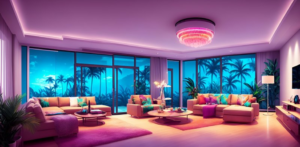Can Light Affect the Color of My Paint?
September 2, 2023

When kicking off any type of interior paint project, one thing at the forefront of every homeowner’s mind is choosing colors that work well for the end goal. But did you know that both natural and artificial lighting can play a significant role in how the color of paint appears in your home? That said, understanding how light affects paint can help you make an informed decision that creates the ambiance you’re looking for inside your abode. Here’s a closer look at the fascinating interplay between light and paint color, along with some factors to consider when making your choice.
How Does Natural Light Affect the Color of Paint?
Natural light, or light that enters through your home’s windows, heavily influences how colors appear in a room and should be considered when choosing paint colors. The effect this light has depends heavily on the direction in which it enters the room and the position of the sun—north-facing rooms generally receive softer, cooler light compared to rooms with southern exposure, which receive the most intense light. This can cause darker colors to seem brighter than normal, and lighter colors to give the room a washed-out feel. The intensity of the light is also a factor; direct sunlight can make colors appear more vivid, while cloudy or overcast days may soften the hues.
Can Artificial Light Change the Color of Paint?
Interior artificial light should also be tested before choosing your paint colors. This residential lighting is usually a combination of bulbs with varying warmth and brightness, and depending on the type you’re using in a particular room, the effect it can have on the paint color will vary. These light sources also come in different temperatures—incandescent bulbs emit a warm, yellow light, while fluorescent lights produce cooler, blueish tones. The placement of these fixtures can also create shadows and highlights, further influencing the surrounding colors. Consider the location of your wall sconces, floor lamps, and overhead lighting and test where they cast shadows and patterns of light, and then plan accordingly.
What Else Should I Consider When Selecting a Paint Color?
A major part of choosing paint colors is also deciding what type of finish would work best with particular lighting. Certain finishes, including flat, gloss, semi-gloss, etc. can all play a role in how colors appear; for example, gloss can add depth, but under certain light it can be quite reflective, meaning that the glossier the finish, the more light will bounce off and distort the color’s appearance.
Particular colors might also change when exposed to specific types of light. Whites and off-whites might seem vanilla, but they’re usually adaptable to all light conditions, as are many shades of pale colors. However, they can sometimes reflect hue from certain objects in the room like furniture or rugs. Also, brighter and richer colors can become problematic under different lighting; khaki, sage, and taupe are all quite prone to change!
About Platinum Painting
The team at Platinum Painting of Richardson has assisted hundreds of homeowners across Richardson and the rest of the DFW metroplex with a wide variety of painting projects over the last 15 years, and they’d love to help you with your next exciting undertaking! If you have any questions about the blog or you’d like to arrange a FREE in-home estimate, feel free to contact the Platinum Painting team online or by phone for assistance. Telephone: (469) 283-6012.
No Comments
No comments yet.
RSS feed for comments on this post.
Sorry, the comment form is closed at this time.
